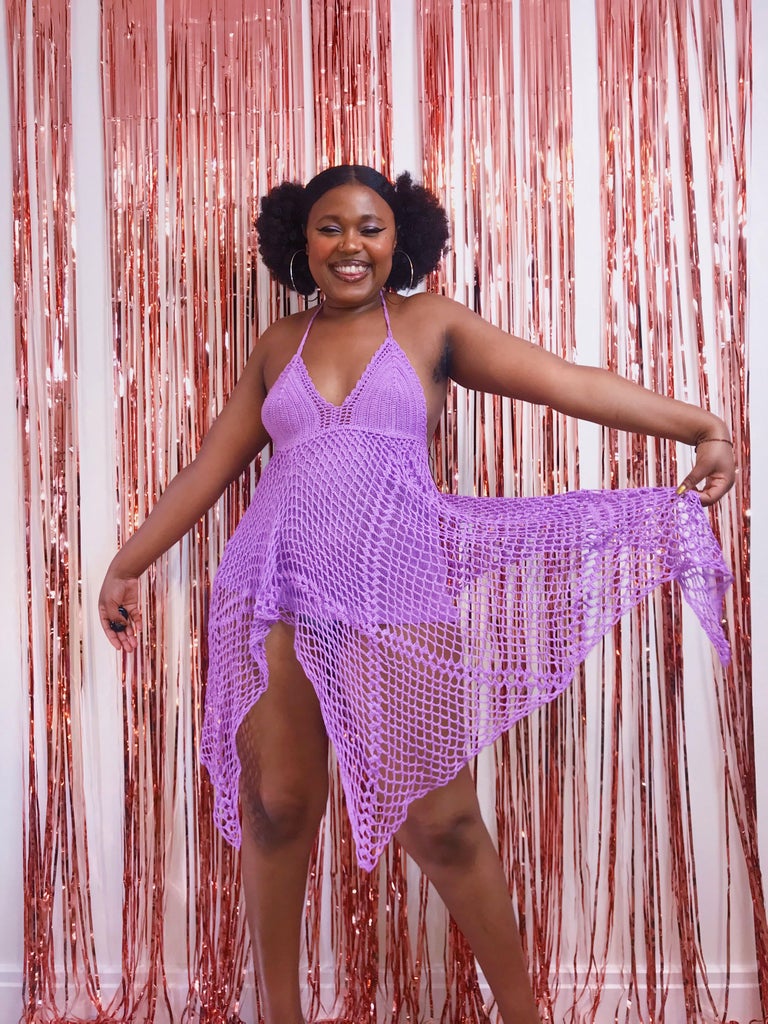
From scrolling through Depop on your smartphone to striking a deal over Instagram DM, the world of vintage shopping has embraced the digital age. While online platforms have made secondhand shopping more accessible in terms of geographical location (living in a big city is no longer a prerequisite for finding vintage gems), if you’re not straight-size the search is still much harder. Echoing an issue we see across the fashion industry as a whole, vintage shopping is much more suited to those with thin privilege.

This is something Katty Patterson, a thrifting lover who’s been selling vintage since 2007, has experienced firsthand. As a size 10 she had “the pick of the shop” but as a size 16 it was a different story. “I felt like I was getting the dregs. When looking for a size 16 you would always end up with the polyester nylon zip-up from the ’70s in some mad print,” she told me. “If you are bigger than a size 14, you’re sourcing from a smaller pool while if you are standard size you could probably find 50 vintage sellers in just one county and pick and choose for your budget,” she added. However, with her determination to change the narrative and her years of experience at sourcing vintage, Patterson has discovered that finding more size-inclusive pieces is definitely possible. She now sells premium vintage womenswear for curvier women through her online Etsy store, Finds by Foxes.
From ditsy print ’70s dresses to ’80s linen blouses, Patterson styles and models each piece she sources herself (check out her IGTV for some great styling videos). The demand is there – 16 is the UK’s average dress size – and the majority of her sales come through women searching for “size 16 vintage” on Etsy. “I hate the idea of settling. I want to find pieces that people think I wish that were in my size but it is.”

Lapoze McTribouy discovered vintage as a broke student with “huge hips and a big butt” who struggled to find clothes she could wear. “It was really depressing and I ended up sourcing my own,” she explains. Her passion and skill for finding pieces evolved into a business, selling via her website Sooki Sooki Vintage, Depop and ASOS marketplace. “I realised a lot of big girls found it hard to find beautiful vintage clothes. I wanted to be size-inclusive. I feel like it’s an erasure of big people to say we only sell size 6-14 and if you’re bigger than that, then you’re on your own.” Much like Patterson, McTribouy models and styles all her pieces. With women’s clothes sizing notoriously unreliable at the best of times, she also makes sure to include measurements of pieces so buyers know exactly what they are getting.
In the past few months McTribouy has noticed a shift in accessibility across the vintage space. “With the promotion of Black creators as a result of the Black Lives Matter movement, people have been noticing that there are Black vintage sellers out there. This movement has connected people – not just Black people but people of all colours and shapes, sizes.”

For Lauren Ashley Gordon, an influencer and founder of the blog Dilan and Me, 2020 has also made her rethink some of her choices. “We are all posting our black squares but what difference does it make? With shopping, I can put my money where my mouth is,” she says. As a plus-size woman, Gordon has struggled to find ethical brands that cater for her. “So many of the sustainable brands forget plus-size people exist. There’s a denial that we’re around,” she notes. Similarly, on sites like Depop it’s (quite literally) slim pickings.
When Gordon started talking to her audience about the issue of accessibility within ethical fashion, she was inundated. “I had lots of people messaging saying, ‘I want to shop more ethically but fast fashion shops are the only places that cater to my size’.” She decided to take action and create a Facebook group called Plus Size UK BST (buy, sell, trade). “I wanted to create a space specifically for plus-size women that want to be more mindful of their impact on the environment and other human beings,” she explained. Since launching a month ago, the group has grown to nearly 500 women who are selling pieces and putting out requests for items they’re struggling to find in their size. It’s a friendly and supportive space which champions slow fashion and allows women to support other women as opposed to large (and often unethical) corporations.

Vintage fashion – defined as pieces that are 20 to 100 years old – in larger sizes is always going to be harder to find, considering the change in body shapes over the last century. However Mandie Voukanari, the founder of Lofty Frocks, has created a way to enjoy vintage whatever your size by upcycling fabrics and tailor-making dresses to your exact measurements. “I wanted to create dresses made from fabrics that had a story behind them,” she told me. Shoppers choose one of Voukanari’s designs (the puff-sleeve maxi dresses are reminiscent of The Vampire’s Wife) and a fabric from her library of vintage options. Voukanari then makes the piece to their exact measurements within five or six weeks. It’s a slower approach to vintage shopping that both prevents waste and creates a unique piece that will fit you like a glove.
These women are certainly making vintage a more accessible space but there is still a way to go. “We need more plus-size people selling,” touts Patterson as one suggestion. “People need to be educated on the benefits of shopping sustainably,” says McTribouy, adding: “I want to help people see the glory and the beauty in buying vintage.” After all, as Gordon succinctly puts it: “We all want to look nice and make ethical choices.”
Like what you see? How about some more R29 goodness, right here?
Fashion Needs Plus-SIze Education